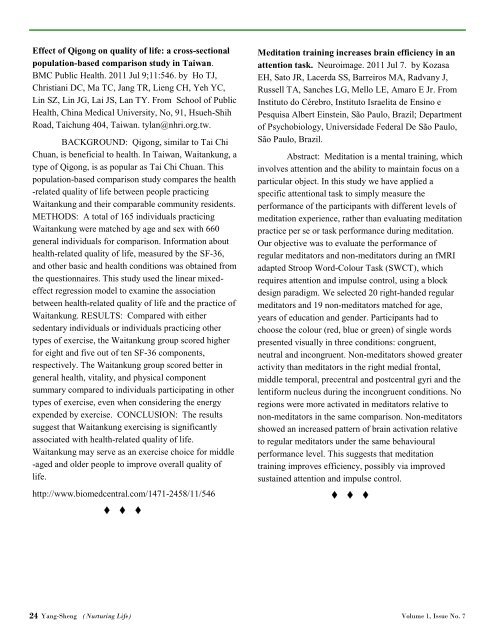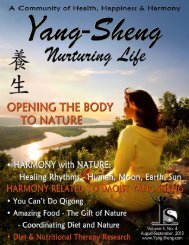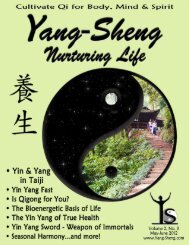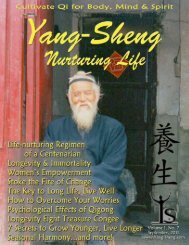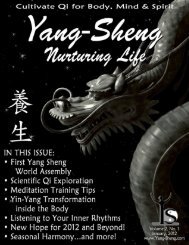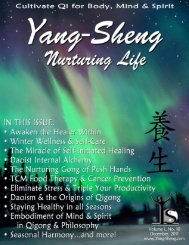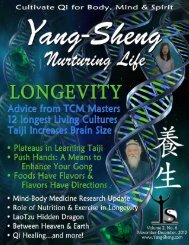Click to download the entire September issue as a PDF - Yang-Sheng
Click to download the entire September issue as a PDF - Yang-Sheng
Click to download the entire September issue as a PDF - Yang-Sheng
You also want an ePaper? Increase the reach of your titles
YUMPU automatically turns print PDFs into web optimized ePapers that Google loves.
Effect of Qigong on quality of life: a cross-sectional<br />
population-b<strong>as</strong>ed comparison study in Taiwan.<br />
BMC Public Health. 2011 Jul 9;11:546. by Ho TJ,<br />
Christiani DC, Ma TC, Jang TR, Lieng CH, Yeh YC,<br />
Lin SZ, Lin JG, Lai JS, Lan TY. From School of Public<br />
Health, China Medical University, No, 91, Hsueh-Shih<br />
Road, Taichung 404, Taiwan. tylan@nhri.org.tw.<br />
BACKGROUND: Qigong, similar <strong>to</strong> Tai Chi<br />
Chuan, is beneficial <strong>to</strong> health. In Taiwan, Waitankung, a<br />
type of Qigong, is <strong>as</strong> popular <strong>as</strong> Tai Chi Chuan. This<br />
population-b<strong>as</strong>ed comparison study compares <strong>the</strong> health<br />
-related quality of life between people practicing<br />
Waitankung and <strong>the</strong>ir comparable community residents.<br />
METHODS: A <strong>to</strong>tal of 165 individuals practicing<br />
Waitankung were matched by age and sex with 660<br />
general individuals for comparison. Information about<br />
health-related quality of life, me<strong>as</strong>ured by <strong>the</strong> SF-36,<br />
and o<strong>the</strong>r b<strong>as</strong>ic and health conditions w<strong>as</strong> obtained from<br />
<strong>the</strong> questionnaires. This study used <strong>the</strong> linear mixedeffect<br />
regression model <strong>to</strong> examine <strong>the</strong> <strong>as</strong>sociation<br />
between health-related quality of life and <strong>the</strong> practice of<br />
Waitankung. RESULTS: Compared with ei<strong>the</strong>r<br />
sedentary individuals or individuals practicing o<strong>the</strong>r<br />
types of exercise, <strong>the</strong> Waitankung group scored higher<br />
for eight and five out of ten SF-36 components,<br />
respectively. The Waitankung group scored better in<br />
general health, vitality, and physical component<br />
summary compared <strong>to</strong> individuals participating in o<strong>the</strong>r<br />
types of exercise, even when considering <strong>the</strong> energy<br />
expended by exercise. CONCLUSION: The results<br />
suggest that Waitankung exercising is significantly<br />
<strong>as</strong>sociated with health-related quality of life.<br />
Waitankung may serve <strong>as</strong> an exercise choice for middle<br />
-aged and older people <strong>to</strong> improve overall quality of<br />
life.<br />
http://www.biomedcentral.com/1471-2458/11/546<br />
<br />
<br />
Meditation training incre<strong>as</strong>es brain efficiency in an<br />
attention t<strong>as</strong>k. Neuroimage. 2011 Jul 7. by Koz<strong>as</strong>a<br />
EH, Sa<strong>to</strong> JR, Lacerda SS, Barreiros MA, Radvany J,<br />
Russell TA, Sanches LG, Mello LE, Amaro E Jr. From<br />
Institu<strong>to</strong> do Cérebro, Institu<strong>to</strong> Israelita de Ensino e<br />
Pesquisa Albert Einstein, São Paulo, Brazil; Department<br />
of Psychobiology, Universidade Federal De São Paulo,<br />
São Paulo, Brazil.<br />
Abstract: Meditation is a mental training, which<br />
involves attention and <strong>the</strong> ability <strong>to</strong> maintain focus on a<br />
particular object. In this study we have applied a<br />
specific attentional t<strong>as</strong>k <strong>to</strong> simply me<strong>as</strong>ure <strong>the</strong><br />
performance of <strong>the</strong> participants with different levels of<br />
meditation experience, ra<strong>the</strong>r than evaluating meditation<br />
practice per se or t<strong>as</strong>k performance during meditation.<br />
Our objective w<strong>as</strong> <strong>to</strong> evaluate <strong>the</strong> performance of<br />
regular medita<strong>to</strong>rs and non-medita<strong>to</strong>rs during an fMRI<br />
adapted Stroop Word-Colour T<strong>as</strong>k (SWCT), which<br />
requires attention and impulse control, using a block<br />
design paradigm. We selected 20 right-handed regular<br />
medita<strong>to</strong>rs and 19 non-medita<strong>to</strong>rs matched for age,<br />
years of education and gender. Participants had <strong>to</strong><br />
choose <strong>the</strong> colour (red, blue or green) of single words<br />
presented visually in three conditions: congruent,<br />
neutral and incongruent. Non-medita<strong>to</strong>rs showed greater<br />
activity than medita<strong>to</strong>rs in <strong>the</strong> right medial frontal,<br />
middle temporal, precentral and postcentral gyri and <strong>the</strong><br />
lentiform nucleus during <strong>the</strong> incongruent conditions. No<br />
regions were more activated in medita<strong>to</strong>rs relative <strong>to</strong><br />
non-medita<strong>to</strong>rs in <strong>the</strong> same comparison. Non-medita<strong>to</strong>rs<br />
showed an incre<strong>as</strong>ed pattern of brain activation relative<br />
<strong>to</strong> regular medita<strong>to</strong>rs under <strong>the</strong> same behavioural<br />
performance level. This suggests that meditation<br />
training improves efficiency, possibly via improved<br />
sustained attention and impulse control.<br />
<br />
24 <strong>Yang</strong>-<strong>Sheng</strong> (Nurturing Life) Volume 1, Issue No. 7


